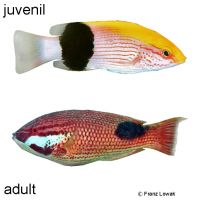Tarry Hogfish (Bodianus bilunulatus)
| Tarry Hogfish Bodianus bilunulatus | |
|---|---|
| Name | Tarry Hogfish |
| Name Lat. | Bodianus bilunulatus |
| Family | Wrasses |
| Family lat. | Labridae |
| Order | Wrasses & Relatives |
| Order lat. | Labriformes |
| Origin | Indo-Pacific |
| Habitat | Reefs |
| Diet | Carnivore |
| pH | 8,1-8,4 |
| Hardness | 8-10 °KH |
| Behavior | Semi-aggressive |
| Keeping | Individual, pair |
| Reef Compatible | With caution |
| Care Level | Moderate |
| Life Span | 5-10 years |
| Protection | No |
| Metric Units | |
| Size | 50 cm |
| Temperature | 22-27 °C |
| Salinity | 33-36 ‰ |
| Aquarium | ~ 1.100 l |
| US Units | |
| Size | 20" |
| Temperature | 72-81 °F |
| Salinity | 1.020-1.025 sg |
| Aquarium | ~ 290 gal |
Distribution and habitat
The distribution area of Bodianus bilunulatus is the Indian and Western Pacific Oceans, from East Africa to Indonesia and Hawaii. They live mostly on reefs with rich sponge and coral growth (gorgonians) to great depths.
Maintenance
They are keen swimmers and require a well-structured aquarium with plenty of swimming space, a reef structure (hiding and retreat possibilities) with live stones, which act like a biological filter, as well as sand areas, made of fine sand at least 20 cm deep (no coral rubble!). Only lime-rich, heavy metal-free sands, gravels or stones may be used.
Filters, skimmers and heaters are necessary to ensure water quality, as well as pumps to simulate tides, swells and bottom currents. Lighting must be appropriate for the species' day-night rhythm
| Salinity: 33-36 ‰ | pH value: 8.1-8.4 |
| Carbonate hardness: 8-10 °KH | Nitrate content: 2-8 mg/l |
| phosphate content: 0.01-0.1 mg/l | nitrite content: 0.0-0.05 mg/l |
For salinity, an average value should be aimed for, which may only vary slightly by +/- 0.5 ‰. Ammonia and ammonium must not be measurable. Special attention must be paid to constantly good water quality.
Diet
Juveniles act as cleaner fish and eat parasites, adults feed mainly on snails, worms, mussels and small fish. The food change usually succeeds without problems. The food supply should consist of a combination of mysis, krill, artemia, smelt, shrimp, mussel and crab meat, or a commercially available vitamin-enriched frozen food mix. High-quality flake and granulated food is also often accepted after a period of acclimation
It is recommended to feed small portions several times a day. This reduces intra-species aggression and protects lower animals in the aquarium. Regular and varied feeding promotes health and increases resistance.
Behaviour and compatibility
The young fish, mostly females, are peaceful among themselves and can be kept without problems. With the sex change to male, the aggression increases. Adults live mostly as loners and should only be socialized with robust and lively fish.
Sex dimorphism
They are protogynous hermaphrodites, meaning that most males develop from functional females when needed, and are referred to as "secondary males." External distinguishing characteristics are not known.
Reproduction and breeding
There are no known reports of successful breeding in the aquarium
Important
Their color dress varies greatly depending on their age. As reef dwellers, they should not be kept in a fish-only aquarium. With sufficient and varied feeding, which also reduces aggressiveness, they can be kept well with invertebrates (corals), only tubeworms, snails, crabs etc. should be kept with caution
When threatened, they sometimes bury themselves in the sandy substrate.
If different species are kept together, make sure that the fish match each other in terms of water quality and temperature requirements as well as their social behavior, and that the setup meets the needs of all species kept together. Newly introduced fish must be acclimated slowly to the water in the aquarium
Further literature can be found in your pet store.
References
Text: Werner Winter; Image: Franz Lowak
Source: KUITER & DEBELIUS (2007): Atlas der Meeresfische: Die Fische an den Küsten der Weltmeere, Kosmos Verlag; ENGELMANN (2005): Zootierhaltung - Tiere in menschlicher Obhut: Fische, Verlag Harri Deutsch
- Gemäß § 21 Abs. 5 Tierschutzgesetz idgF
